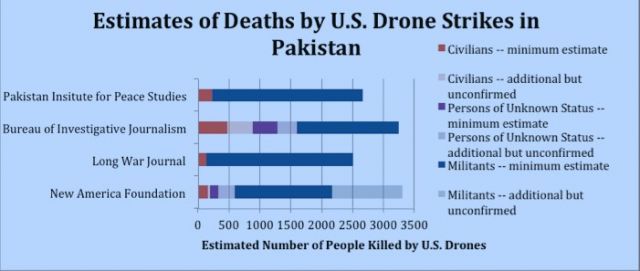Welcome to DU!
The truly grassroots left-of-center political community where regular people, not algorithms, drive the discussions and set the standards.
Join the community:
Create a free account
Support DU (and get rid of ads!):
Become a Star Member
Latest Breaking News
Editorials & Other Articles
General Discussion
The DU Lounge
All Forums
Issue Forums
Culture Forums
Alliance Forums
Region Forums
Support Forums
Help & Search
General Discussion
In reply to the discussion: 6 Unanswered Questions About Obama's Drone War [View all]G_j
(40,531 posts)11. The Drone Unknowns
http://www.motherjones.com/mojo/2012/10/what-we-dont-know-about-drones
The Drone Unknowns
—By Adam Serwer| Mon Oct. 1, 2012 7:15 AM GMT
We don't know how many civilians are killed in drone strikes, but we do know the US government is almost certainly wrong about it.
That's one conclusion you could draw from a report on the impact of the use of drones in targeted killing by the the Human Rights Clinic at Columbia Law School and the Center for Civilians in Conflict*, released Sunday, a year to the day that radical American cleric Anwar al-Awlaki was killed in a drone strike in Yemen. While the US government has maintained that few if any non-militants are killed in drone strikes, reports about how targeting decisions are made, the realities of airborne warfare, and the basic fallibility of humankind call the Obama administration's claims of precision into question. There's also the problem that some behaviors which might seem to indicate "guilt" out of context, like carrying a gun, are common in the areas being targeted. "A civilian carrying a gun, which is a cultural norm in parts of Pakistan, does not know if such behavior will get him killed by a drone," the report notes. While "personality" strikes are aimed at specific individuals, the government also conducts "signature strikes" which hit anonymous individuals on the basis of a "pattern of behavior."
Because the government has yet to even officially acknowledge the existence of the CIA's targeted killing program or its military counterpart in the Joint Special Operations Command however, it's hard to evaluate the Obama administration's claims about avoiding civilian harm. The report notes that the dearth of first-hand information from the areas most frequently targeted by drone strikes means that determining who is a "militant" and who is not, particularly after the fact, is very difficult. That's why third-party estimates, which cast serious doubt on the government's assessments, vary so widely, and why the Obama administration itself may not even know how many civilians are being killed. Here's a chart from the report:
[URL= .html][IMG]
.html][IMG] [/IMG][/URL]
[/IMG][/URL]
The Drone Unknowns
—By Adam Serwer| Mon Oct. 1, 2012 7:15 AM GMT
We don't know how many civilians are killed in drone strikes, but we do know the US government is almost certainly wrong about it.
That's one conclusion you could draw from a report on the impact of the use of drones in targeted killing by the the Human Rights Clinic at Columbia Law School and the Center for Civilians in Conflict*, released Sunday, a year to the day that radical American cleric Anwar al-Awlaki was killed in a drone strike in Yemen. While the US government has maintained that few if any non-militants are killed in drone strikes, reports about how targeting decisions are made, the realities of airborne warfare, and the basic fallibility of humankind call the Obama administration's claims of precision into question. There's also the problem that some behaviors which might seem to indicate "guilt" out of context, like carrying a gun, are common in the areas being targeted. "A civilian carrying a gun, which is a cultural norm in parts of Pakistan, does not know if such behavior will get him killed by a drone," the report notes. While "personality" strikes are aimed at specific individuals, the government also conducts "signature strikes" which hit anonymous individuals on the basis of a "pattern of behavior."
Because the government has yet to even officially acknowledge the existence of the CIA's targeted killing program or its military counterpart in the Joint Special Operations Command however, it's hard to evaluate the Obama administration's claims about avoiding civilian harm. The report notes that the dearth of first-hand information from the areas most frequently targeted by drone strikes means that determining who is a "militant" and who is not, particularly after the fact, is very difficult. That's why third-party estimates, which cast serious doubt on the government's assessments, vary so widely, and why the Obama administration itself may not even know how many civilians are being killed. Here's a chart from the report:
[URL=
 .html][IMG]
.html][IMG] [/IMG][/URL]
[/IMG][/URL]Edit history
Please sign in to view edit histories.
Recommendations
0 members have recommended this reply (displayed in chronological order):
49 replies
 = new reply since forum marked as read
Highlight:
NoneDon't highlight anything
5 newestHighlight 5 most recent replies
RecommendedHighlight replies with 5 or more recommendations
= new reply since forum marked as read
Highlight:
NoneDon't highlight anything
5 newestHighlight 5 most recent replies
RecommendedHighlight replies with 5 or more recommendations
Ran out of what? Drones or terrorists? No can't be terrorists, they will never run out,
A Simple Game
Feb 2014
#17
Bwahahahaha! There's an endless supply of that. Just cut social services and voila!
valerief
Feb 2014
#32